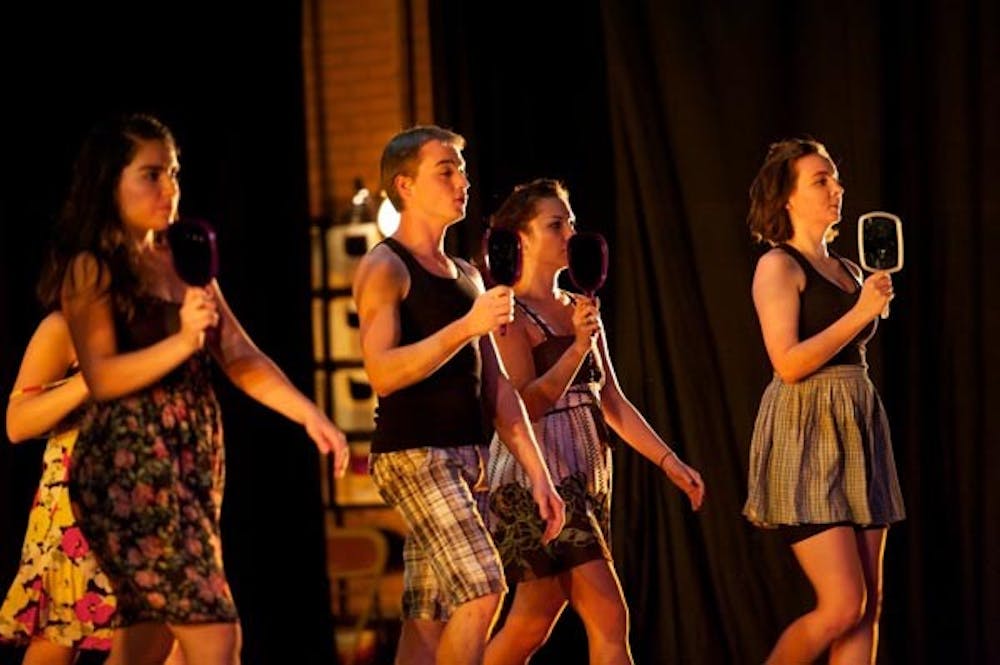Not an open seat in the house as students, friends and families filled the Margaret Gisolo Dance Studio on ASU’s Tempe campus Wednesday night and waited patiently for the Graduate Project Presentations dance performance to begin.
The culmination of eight graduate student’s work, each piece in the performance symbolized a different concept; almost all pieces were done in modern style of dance.
“We weren’t given any sort of direction. Every choreographer was working from their own independent project specific to their studies,” said Laurel Wall-MacLane, a dance graduate student.
But the performance was not only about the choreography, but collective work of the dancers in the program as well.
“I’ve been dancing since I was five-years-old. Growing up in an extremely artistic home, dance has always been my passion,” said Britta Peterson, a dance and communication graduate student. “While at times it can be really fun and exciting, it can also be an intellectual workout.”
Not only did the students choreograph their own dance for the show, they also designed the costumes, and several of them edited their own music. Many of the students chose to cast an open audition for dancers as well.
However, only about half of the students chose to perform in their work, while the other four watched in excitement from the balcony area.
“At the graduate level we often chose not to dance in our own pieces when using a large group because it’s very hard to have an objective eye when you’re in the dance,” said Peterson. “I believe it’s more difficult when you’re not able to see it from the audience’s perspective.”
On the side, the students also run a production organization called Junk Drawer, which they use to produce all of their shows. Each class chooses two representatives to discuss the organization in meetings held monthly.
“It’s called Junk Drawer because it’s kind of the catch-all for all of the issues we have in our program,” said Peterson.
Junk Drawer and the faculty put on most of the performances so that the students have a place to showcase their work and receive feedback from professors.
“The department is really awesome; you saw so many different dances and so many people were involved in this production. It really does take a community to bring this all together,” said Peterson.
The program opened with a modern movement piece called “The Body Electric,” which incorporated many uplifting phrases and definitions being said throughout the dance.
Many of the pieces in the show included serious subject matters with a darker and emotional appeal.
“The edgier ones showed the biggest range in movements,” said Amy Augsburger, a junior education major at ASU.
While some of the pieces were still labeled as a work in progress, many of them appeared completed.
“I’m working on an experimental piece, inspired by a poem I wrote,” said Wall-MacLane. “I wanted to give it a certain atmosphere, and not knowing many people in this area, I felt I would be able to convey my message the best right now.”
Peterson has only been working on her performance since early September and she feels it’s a bit more lyrical rather than modern. She says her inspiration came from a documentary called “No Impact Man” and her love for a tight-knit community.
Her piece “(dis) Connected” featured about 20 dancers on what appeared to be a type of public transit mixing their common love for dance with different athletic movements.
“I wanted it to be really simple for the audience; I wanted them to witness this community experience about being happy and peaceful with one another,” said Peterson. “It’s relatively short for the dance world actually, but you know short and sweet is always an audience favorite.”
The final piece of the night focused mainly on communication. It used several techniques to communicate a somber message to the audience.
“I feel that some of the more serious presentations were very successful in the way they packaged their ideas,” said Peterson.
Many of the students see themselves as more than just a dancer in their career.
“I want to continue to choreograph in the future and I am also looking into becoming a teacher,” said Wall-MacLane.
Peterson hopes to accomplish many things after she receives her master’s degree and says that ASU’s creativity and leadership roles have helped her to perfect cutting edge techniques.
“In the future, I see myself as a professor and I see myself running my own non-profit dance organization, whether that’s a company or a rehabilitation studio; but I see myself as an artist above all.”
Reach the reporter at alicia.diaz@asu.edu





